It is an irony that a large section of educated people know little about Isaac Newton. For them he is just another scientist who is nothing more special than a radio inventor or a rocket maker. They don’t realize the importance of Newton’s work. His principles of motion and law of gravity is the very soul of modern physics. He was the father of physics and much more than that. Newton was a multi-faceted person with many talents. His works in the various fields are summarized here for the benefit of the readers.
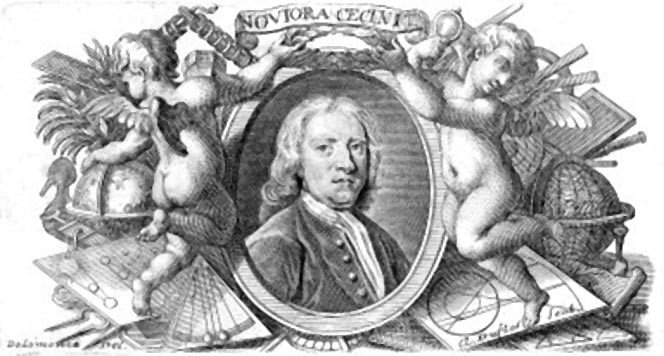
OPTICS
Even as a student around 1664 Newton had studied the phenomena of vision and light. Till then only Robert Boyle and Robert Hook had done some work in that field. Newton also studied the mathematical and physics research works of the French philosopher and scientist Rene Descartes. That was the period when colleges had been shut down due to plague epidemic and Newton had returned home. He experimented with light reflection and refraction through a glass prism. After experiments, study and research Newton worked out theories and principles on colours, light and colour scheming. He rigged up a reflective telescope called Newtonian Telescope to prove his points.
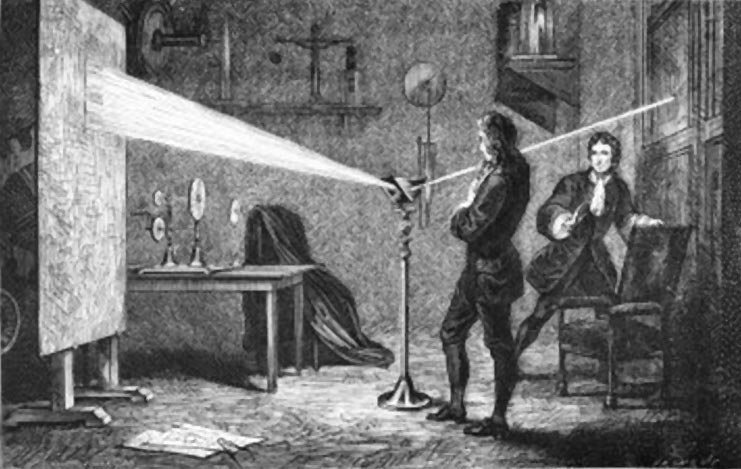
Newton proved by demonstration that white light was made up of rainbow colours. For example he showed rainbow colours in spectrum form. Through spectrum he split several coloured light rays from a white beam of light. From different angles he demonstrated reflection of light through a transparent medium and proved his new theory and point. In support of his research Newton showed how a thin film gave the feeling of the presence of colours upon viewing from different angles.
Newton said when drops of oil are put in water they too act as prisms and reflect coloured rays. He also showed soap foam that appeared white at a cursory glance but close observation revealed they too shimmered with coloured light reflections. To further prove his point he subjected a thick layer of film to a steady light beam and demonstrated colour schemes from different angles emerging in varying patterns.
Before this research theory of Newton it was believed that while light had independent existence and it did not photosynthesize any ray or reflected any coloured light ray. It was a new discovery and Newton proved it by demonstration but it was not readily accepted as is human tendency to recoil from a new idea.
Till 1668 Newton had refrained from making his new research public as it was based on non-traditional format. But in 1672 and 1675 he revealed it upon second thoughts. It was a new concept. Some reacted sharply and dismissed it straight away. Old minds were not ready to believe that while light could be made up of coloured rays. Inspite of opposition Isaac Newton got his new theory published in science journals. But finally Newton decided to let the period of rabid disbelief pass away.
In only 1692 his theories on light and colour schemes got published in a book form. By that time his sworn detractors had gone to sleep in their graves. But still the book was not totally accepted. There was some scope for doubts in respect of some principles and theories. Newton felt bad about his inability to properly propound the principles of light synthesis. But it is a historic truth that a principle that has truth in its core one day gets accepted. Around 1715 Newton’s concept of Optics theory got recognized and accepted. The optics experiments were tested for veracity and his concepts on optics received acceptance. But in the context of this important research the following remarks would reveal that during the lather half of 17th century and early quarter of 18th century how difficulty it was to offer new ideas and concepts :
- Isaac Newton’s research started when he was yet a 21 year old in 1664.
- For the next four years Newton not only worked on the basic of non traditional ideas but kept his research unpublished to test his concepts with several experiments for veracity and confirmation for truth.
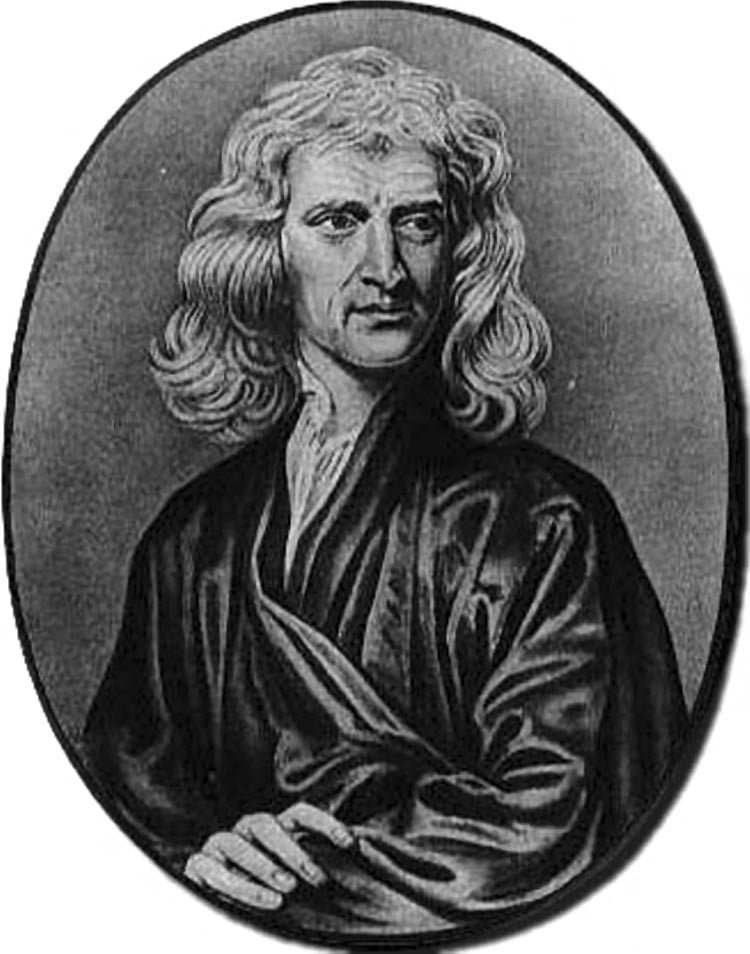
- For the first time Newton unraveled his research on the new idea and upto 1675 he worked hard to support his findings.
- Inspite of several demonstrations and explanations Newton’s Optics principles were not accepted. The people saw the experiments prove his points but they preferred to disbelieve what they were seeing.
- In 1681 Newton again tried to prove his theories and concepts through live experiments but the orthodox minds refused to accept the truths.
- In 1692 when all his sworn enemy detractors had gone to graves did Newton publish his theories in a book form but there was need for some amendments and corrections.
- In 1715 Newton’s findings and principles faced the scientific test tables. They passed the tests to become certified facts.
- In this way the readers can see that it took Newton 51 years to work on and present a new concept and get it accepted. It shows how a man with new ideas faced opposition during that orthodoxy oriented period. It was like a scientific crusade.
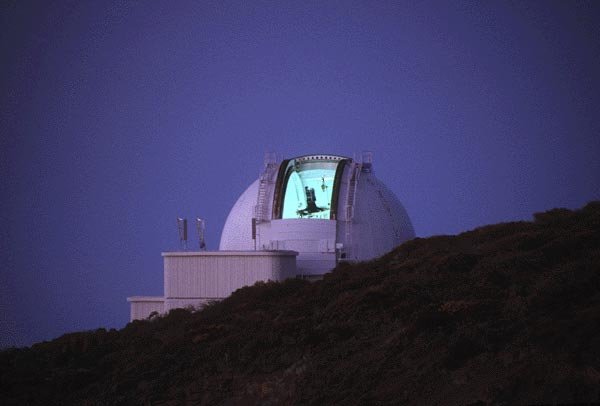
MATHEMATICAL CONCEPT
Newton was a person with a dogged determination. Nothing could put him down or dampen his spirits. Instead of getting freaked out he turned to the mathematical researches. In the early education days he had shown some talents in mathematics. During those days he had prepared some notes on mathematical problems that had impressed his teachers. In school he had Geometry as his special subject but Newton later said the overall mathematical education was his own effort and had gained the knowledge by self-study. It is a fact that he had learnt higher mathematics from the books of William Auturd and John Wallis. He had tried to imbibe the knowledge of all the departments of mathematics. But what earned him successes were Analytical Geometry. Differentiation and Integration. Newton found the answers to the problems related to the curved lines and touch lines. The ‘Method of Fluxions’ really got him the fame and admiration of others. Later Newton presented his works in a proper and systematic way in his book Principia. But in the advanced age period Newton apologized for his mathematics of that time clarifying that Geometric system of classical Greek was more refined.
Newton’s work Cubic Curves was also appreciated. His 1673–1683 Cambridge lectures were published in 1707.
FIRST CONTROVERSY OF CALCULUS
Newton had completed his research on ‘Curved Lines’ and method of Fluxions by 1666. Thus other mathematicians got the wind of Newton works. In 1668 Newton presented his Method of Integration, In 1675 Gotfreid Wilhelm Leibniz independently presented Differential Calculus and in 1677 Newton was told about it in a cursory manner. Before that Isaac Newton had revealed to Leibniz about his research works in fair details in confidence. But Newton had held back ‘Method of Fluxions’.
In 1684 Leibniz got his Differential Calculus research work published. Some mathematicians examined his work. In 1690 some well wisher friends told Newton that the work of Leibniz appeared to be part of his Differential Calculus and hence the latter may have added that to his Fluxions research.
The friends of Newton said that in 1676 Leibniz had spent some time with Newton during his visit to London had seen Newton’s research work on the Method of Fluxions. The supporters of Leibniz were claiming that he was given no tips on Fluxions by Newton. It became a raging controversy. The supporters of mathematicians exchanged charges and accusations. When the quarrel broke out in open Leibniz also adopted a hostile attitude and attacked Newton. Later he began to criticize Newton’s thoughts about God and gravitational principles. The fight took uglier turn and did not die out even after the death of Leibniz is 1716.
For this reason continent took much time in accepting the researches of Isaac Newton. For a century France kept a ban on English mathematicians to deny them the chance to work with other mathematicians of the continent or exchange notes. It was the reaction to Newton-Leibniz controversy. It fairly shows how it had affected the relations between two nations. Newton’s works were not accepted by the French for a long time before relenting and only then Newton was recognized and honoured.
MECHANICS AND GRAVITATION
After the popular myth of the apple falling from the tree by 1665 and 1667 Isaac Newton had concluded that the same force was powering the moon on its orbital path that brought down the apple from the tree. He had calculated what force the moon needed to stay on its orbital path and cause the fall of the apple from the branch. He had made comparisons of the forces. He had understood the centrifugal force that worked on the stone of the sling and relationship between the length of a pendulum and the time taken for a swing.
Isaac Newton had not discovered all these facts immediately after the apple fell. He had studied for a long time the mysteries of astronomy and learnt the facts about the positions, masses and movements of all the planets of the solar system and their satellites. Newton was a very serious scientific character who won’t jump at conclusions. After becoming sure of the gravitational force he researched on its effects in various conditions and objects.
About the apple falling incident an international joke made rounds in academic circles which is quite hilarious. It is in the form of a dialogue between a student and a teacher.
Teacher : What is the difference between an ordinary man and a genius if we take the incident of the apple falling on Newton’s head to be true?
Student : Newton thought over the incident of the apple falling and discovered the reason but did not eat the apple. An ordinary man would pick up the fallen apple and eat it. Then he would wait for another apple to fall.
Teacher : So, who is genius?
Student : The one who ate the apple and waits for the another to fall!
It may be a joke but in it lies the bitter truth how a common man is tied down to his own selfish interests whereas a genius may try to feel some hidden secret of the nature in everyday incidents.
Between 1679-80 period Newton exchanged letters with his contemporary scientist named Robert Hook. In a letter Newton asked what was the tendency of a body that was away from the earth in orbit and was being worked by centrifugal force? Hook revealed that such celestial bodies tend to move in opposite order and the motion to eliptical. Then, by 1684 Newton entered the field of machines with Edmond Haily. Edmond was impressed with Newton. Newton researched in mechanics too and published his Principia. The book had taken him several years to complete and editions kept being printed. Between those editions Newton’s mechanical research also came out as part of it. In research order it came out as Principia in the following manner :
PRINCIPIA-I : In it Newton presented mechanical science in fundamental form by determining the velocity of celestial bodies on orbital path and the centrifugal force. Before that it was not in the mechanics wing, Newton for the first time officially proved that gravitation impacts the motion of the celestial bodies but then Newton had not discovered that the cause was drag or pull that effects the empty spaces for reasons unknown. Newton had then imagined that the pull between the celestial bodies was same factor.
PRINCIPIA-II: In this book Newton included liquids as the subject of his research. He tried to provide answers to problems regarding motions of the liquids and their velocities or acceleration rates worked through other masses. It also included density of the air and the study of sound waves and their fundamental facts.
PRINCIPIA-III: It is truly the compilation of refined updated and amended final forms of the research works of Isaac Newton. It specially tells about the effect of gravitational force on celestial bodies. The sun and six of its planets are included to show that they remain in motion due to gravitational force just as the moon does in orbiting around the earth. But to prove his theory correct he lacked solid proof and the planets could not be practically experimented with. But he was not far off the truth, today we can say that as man has visited the moon guided by those theories.
About comets Newton claimed gravitation to be the causer. In the following editions Newton said revisits of the comets was also due to gravitational force. In this book Newton visualized that comparatively two bodies of equal mass are celestial bodies and have power like gravitational force. Newton also studied the high tide-low tide effects in them. He analyzed the ionization velocities during the tides and offered explanation about the time when it is solstice. He maintained that gravitation of the sun and the moon were responsible for all the above phenomena. Generally it is seen that a country readily accept the findings of a scientist of its native origin. Then other countries may follow. So it happened with Newton. The new theories, laws and principles were accepted in a natural easy way. But rest of the world was slow in accepting Newton. His researches were recognized only 50 years later. We can see how new ideas were never welcome and acceptable at any point of time.
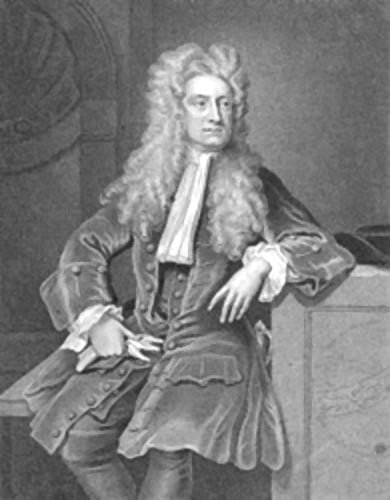
But later the world had to accept grudgingly that the Englishman named Newton indeed was a genius and incredibly talented scientist. He won admiration and great support in global scientific communities and the academic circles. In Newton’s original theories there was scope for refinement and upgradation. In 19th century there were some doubts about Newton’s fundamental principle but Pierre-Simon-Laplas supported it in original form. It was about the principle of ‘Quantum and Relativity’. The original concept was correct. What researches Isaac Newton had done in his time bore fruit centuries later in some cases. His theories and visualizations were proven true in the following centuries.
ALCHEMY AND CHEMISTRY
As already impressed Newton delved in many trades without becoming a jack. He was master in every field and in his case a rolling stone gathers no moss also proved wrong. Newton had no training in alchemy and chemistry but learning and researching in any field was his passion. After his death amongst his papers several manuscripts on alchemy and chemistry were discovered. These papers contained his research and theories in alchemy and chemistry. From the books on those subjects Newton appeared to have learnt a lot and enriched his knowledge and he wished to give something back as well.
Newton manuscripts had considerable notings and data on the works and researches done by earlier alchemist. But there also was his own research. Some of it was original. It is not that chemistry had become his old age pastime. He was interested with subjects in 1669 itself when he left Cambridge. He did some original researching in an effort to unravel some of the mysteries of chemistry still shrouded. It is tradition of alchemists to make repeated experiments to prove one point and take the outcome to be the different attitude. He was more interested in knowing the secret behind those very conclusions. The end result of a chemical reaction was less important for him than the very process of actions of various chemicals, reactions to other and their exact role in the chemical process.
Newton had a deep curiosity to know the chemical compositions of the things of nature and their own molecular structure. All chemicals be it solid, liquid, vapour, gas, jelly, powder or in any form attracted his interest. He believed all things were creation of God worked up by chains of bizarre chemical accidents. For him discovering the truth of a thing was a way to upgrade it. In the context of Optics, in 1710 Newton wrote article on properties of Acids, in which he reiterated his faith in Almighty. He even got a half-done research paper published that could reveal chemical energies to the alchemists. Centuries later, this book of Newton continues to interest the alchemists because he could view things from the angle of a believing natural scientist.
CHRONOLOGICAL STUDY BY NEWTON
Isaac Newton studied books on human nature, anthropology, psychology and religion and wrote many himself which outnumber the mathematics or science books. He wanted to understand the intricate nature of human mind, its thinking and spiritual aspects. In humans Newton had the most mysterious and baffling creatures the nature evolved. No one exactly knows how many books he read to understand spiritual aspect of man and his visualization. He himself wrote book on human welfare and faith in Almighty. His unpublished manuscript Serolis, deals with the humanitarian thoughts. He incorporated these thoughts in the Principia series from time to time. He had got such philosophical thoughts even before Socrates philosophy came to light.
Newton made a deep study of the famous book Fathers of the Church. He also studied Greek mythological legends and the hidden messages of Bible. Newton thought they were the great creations after the human civilizations evolved. He reordered the chronological order of certain events. The important dates of Jewish and Paganic events were determined by Newton according to the logic of the astronomical knowledge of the Greek scholars. He set the time of the fall of Troy to 904BC. Whereas other researches had marked it at 500BC. But the claim of Newton never got verified.
RELIGIOUS FAITH AND PERSONALITY
Isaac Newton had faith in religion and he had some committed views. He had studied Bible deeply. He wrote on Judaeo-Christian prophecy and explained he wanted to understand the God. His book was published during the reign of Queen Victoria that contained all his studies and conclusions regarding the religion. He claimed in 400 AD Christianity had degenerated when Nicara Council presented wrong image of Christ in respect of nature.
Newton’s non traditional thoughts got recognition only in the 20th century. His views on religious Trinitarian effect were accepted as critical observation. According to his own religious inclination Newton supported the theory on the creation as revealed by Bible. When he propounded his scientific laws/principles he acknowledged the helping role of God manifested through the nature and its logical phenomena.
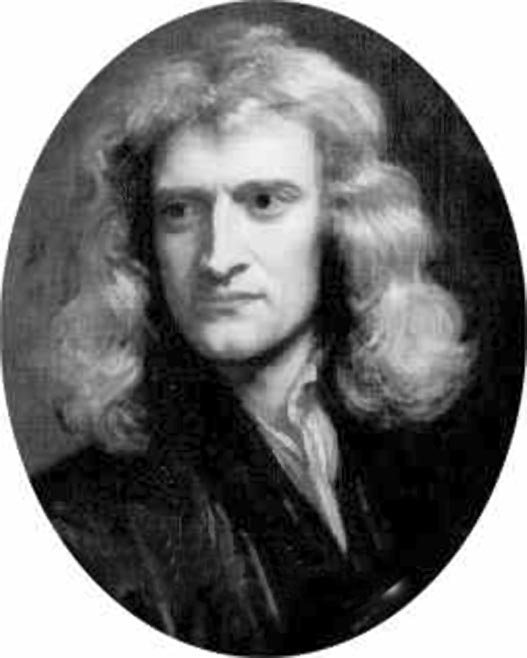
Newton thought the way the nature worked reflected the creativity of Almighty. The nature has been kind to human and all other creatures. It proves that Newton was basically committed to natural sciences and saw the creativity of God in every particle. The more he unraveled the mysteries of nature the more he became God believer. He only opposed those religious concepts that raised questions on God’s existence in natural phenomena.
PUBLICATIONS
Newton’s research papers or books were printed in the following chronological order:
- Newton geographical research was analyzed in the book called Geography in1672 by the German geograprher Varenius.
- No work of Newton was independently published up to 1686. The famous book Principia first brought out its edition in 1687.
- The next editions came out in 1713 and 1726. The editions had different contents.
- In 1704 Optics was printed in English language and in 1706 translated in Latin and published.
- In 1728 Chronology of Ancient Kingdoms Amended posthumously came out. In the same year the System of World get published.
- The first article of Principia was printed with its third edition.
- In 1733 Examination : Soothsaying was published which was in the context of special works of Daniel and St. John.
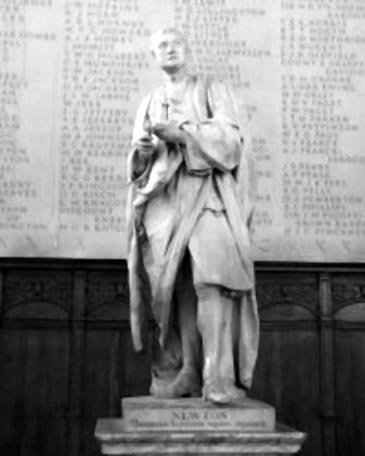
Thus, Newtonian science became popular in the continent and his works were accepted with honour and his laws and principles duly recognized. Peace had descended on Europe after war. In this post 1714 period he came to be known as the greatest scientist of the natural sciences. To many he was scientific philosopher. The last years of Newton were spent in amending and updating his earlier works and he would also reply to the critics even when he continued to serve the Royal Mint.
Newton lived a simple life and humility was a part of his character. As far as criticism is concerned he would accept the fact based on constructive criticism but malice borne diatribe angered him. He was hard on his enemies and generous to friends. As the master of the Royal Mint he revealed his administrative qualities.
Upon his death his body was buried in Westminster Abbey with great honour and ceremony. Till to this day Newton remains the greatest exponent of the natural sciences and so will this fact remain for the future as well because there is unlikelihood of another talent of such calibre coming up.
PATRONS OF NEWTON
It is said that good things happen to good people. It happened with Newton. ‘Opportunities come knocking at the door of talent’ also proved true to make soon for his kind patrons were his first namesake Isaac Barrow. Before we reveal the Isaac Barrow tale it would be appropriate to picture the circumstances of that period. It was the time of 1667. After returning to Cambridge from Woolsthorpe Newton had begun chemistry experiments. In 1668 a mathematician called Nicholas Mercator got a book published on method related to infinite number. Newton read that book and immediately wrote a research paper by the title De-Analysis and sent it. A Cambridge Professor Isaac Barrow too saw the research paper. He sent a copy of it to one of his London based mathematician friend for comments. Barrow and Newton were good friends and they trusted each other. A few days later the friend wrote back to Barrow. His assessment was very encouraging. A few weeks later Newton gave his assent to get the research work published. Thus, for the first time Newton’s work reached the mathematicians of Europe. Now Newton’s talent was doubtlessly accepted.
But then, Newton had no means of living. He needed a job but the job should not make him divorce the academic world. Here Isaac Barrow came to Newton’s rescue. He resigned from the post of Leucasian Professor in favour of Isaac Newton. The post carried salary and was created and started from 1663. Thus due to the generosity of Professor Barrow Newton got that honoured post on which he could live all the time in academic atmosphere and company to carry out his research works alongside. It needs to be noted that Newton was only 21 years old. It was the period when he did his research on alchemy and chemistry subjects. Most the this work was based on books, research papers and experiments carried out by the established alchemists and chemistry scientists.
Newton’s friend Isaac Barrow deserves to be remembered for his sacrifice. The first thing a young man needs after completing education who has no family support or means is a job to sustain him and to keep his upwards move on. A talent needs steady financial base to prosper. Newton was able to carry on his research freed of worries of making a living. Another person who rescued Newton from a bleak future prospect was his uncle teacher Henry Stokes. He intervened when Newton’s strong headed mother got him away form studies to work him on agricultural farm. Henry was able to persuade the woman to send Newton back to school to let him continue with his education. Without his intervention Newton could’ve become an ignoramous farmer. He would have ended up digging potatoes instead of getting an apple fall on his head to work up scientific revolution.
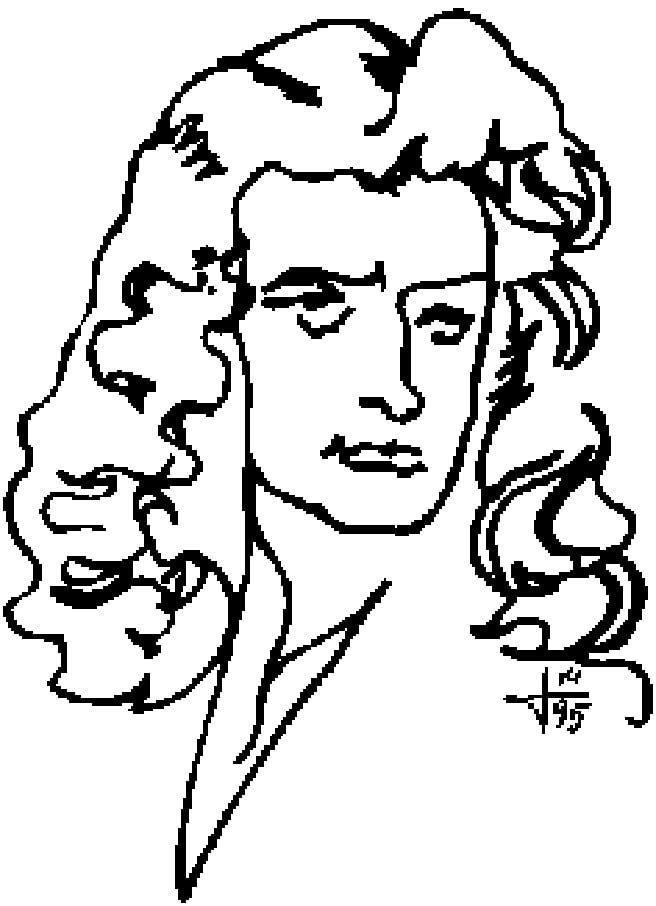
Thus at every stage he met someone who helped him stay on course. When a person’s talent, extraordinary brilliance and capability show up the support comes from some quarter. He got warden’s job with Royal Mint. Newton had already become a famous name in the scientific world when he became Master of the Royal Mint. Twice he was nominated to the British Parliament. The talent and potential of Isaac Newton was saved from getting wasted first by Henry Stokes and then by Isaac Barrow. Henry was instrumental in Newton continuing his education and Barrow got him honourable and academic job. First time when he was nominated to the parliament Newton formally thanked those two gentleman. In that act Isaac Newton showed he was not only a scientist of extraordinary talent but a thankful man who would always remember those who contributed to his unprecedented rise.
